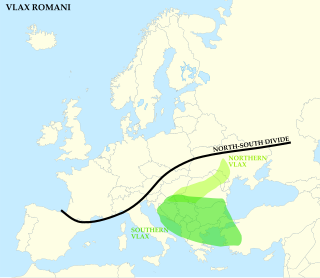

| Vlax Romani | |
|---|---|
| romani shib | |
| Native to | Bosnia, Romania, Serbia, Albania, Hungary, Israel; scattered in numerous other states |
Native speakers | 538,480 (2002–2014)[1] |
| |
| Official status | |
Recognised minority | |
| Language codes | |
| ISO 639-3 | rmy |
| Glottolog | vlax1238 |
| ELP | Vlax Romani |
 | |
Vlax Romani is a dialect group of the Romani language. Vlax Romani varieties are spoken mainly in Southeastern Europe by the Romani people.[2] Vlax Romani can also be referred to as an independent language[3] or as one dialect of the Romani language. Vlax Romani is the second most widely spoken dialect subgroup of the Romani language worldwide, after Balkan Romani.
The language's name Vlax Romani was coined by British scholar Bernard Gilliat-Smith in his 1915 study on Bulgarian Romani, in which he first divided Romani dialects into Vlach and non-Vlach.[4][5] The Vlax Roma, a subgroup of the Romani people that speak the Vlax Romani language, originate from the former Roma slaves in the principalities of Moldavia and Wallachia (with the name "Vlax", which comes from "Vlach", coming from the latter), now Romania.[6] The words Romani and Romania are false cognates, the former deriving from Romani rom – ultimately from Sanskrit word ḍoma/डोम, and the latter deriving from Romanian român – ultimately from Latin.
Vlax Romani is classified in two groups: Vlax I, or Northern Vlax (including Kalderash and Lovari), and Vlax II, or Southern Vlax.[2]
Elšík[7] uses this classification and dialect examples (geographical information from Matras[8]):
| Sub-group | Dialect | Place |
|---|---|---|
| Ukrainian Vlax | - | Ukraine |
| Northern Vlax | Cerhari | Hungary |
| Hungarian Lovari | ||
| Slovakia | ||
| Austrian Lovari | Austria | |
| Polish Lovari | Poland | |
| Norwegian Lovari | Norway | |
| Serbian Kalderaš | Serbia | |
| Italian Kalderaš | Italy | |
| Russian Kalderaš | Russia | |
| Taikon Kalderaš | Sweden[9] | |
| American Vlax | USA | |
| Southern Vlax | Vallachian | Romania |
| Ihtiman | Bulgaria (named after the city) | |
| Gurbet | Serbia and Bosnia Gurbeti | |
| Korça | Albania (named after the city) | |
| Italian Xoraxane | Italy (Xoraxane translates as "Muslims" in the dialect) | |
| Ajia Varvara | Greece (named after a suburb of Athens) |
Vlax Romani is written using the Romani orthography, predominantly using the Latin alphabet with several additional characters. In the area of the former Soviet Union, however, it can also be written in the Cyrillic script.[10]
|
| |||||||||||
|---|---|---|---|---|---|---|---|---|---|---|---|
| Romani varieties |
| ||||||||||
| Mixed varieties |
| ||||||||||
| Writing |
| ||||||||||
| Organizations |
| ||||||||||
| Media |
| ||||||||||
| Related |
| ||||||||||
Italics indicate extinct languages | |||||||||||
This Romani-related article is a stub. You can help Wikipedia by expanding it. |
This article about Indo-Aryan languages is a stub. You can help Wikipedia by expanding it. |